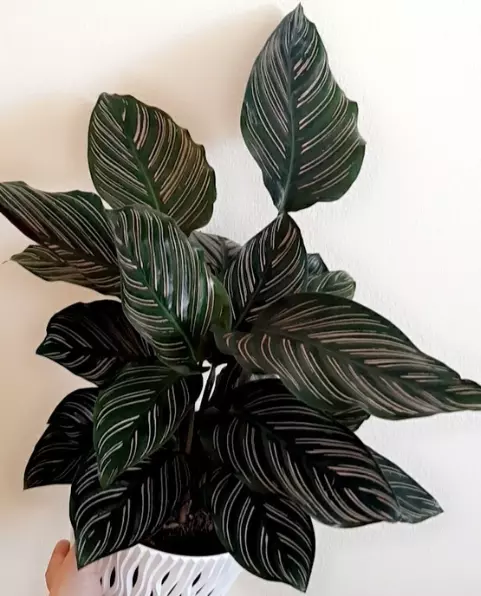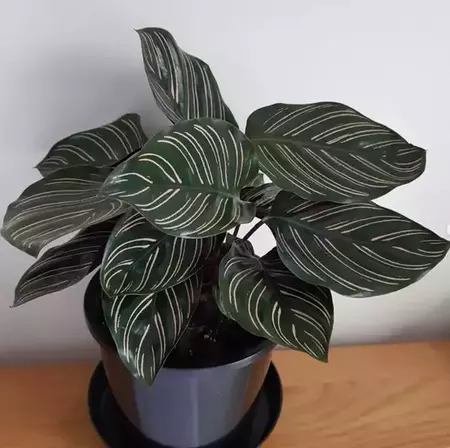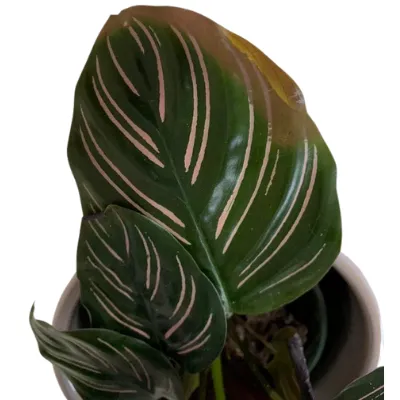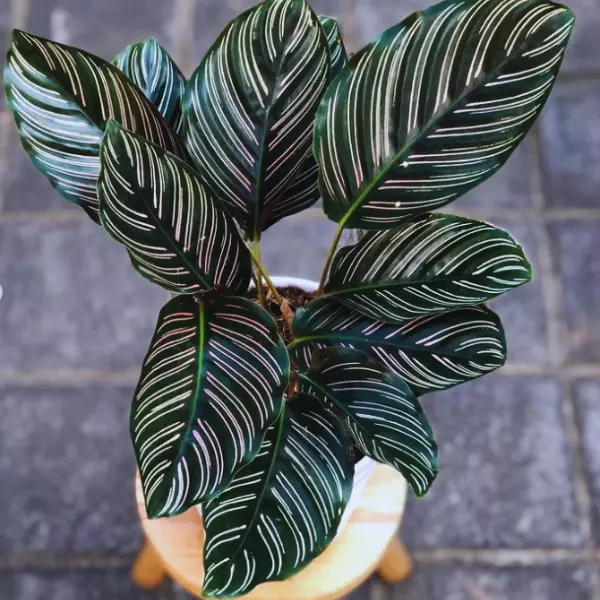The Calathea Ornata is a beautiful but challenging plant with pink stripes on its large green leaves. It can be tricky to care for these tropical plants at times. Calathea Ornata, also known as Pinstripe Calathea, has colorful patterned leaves with violet undersides. These plants are favorites of plant parents and loves them cultivating in a container inside your home. They grow to about two feet tall and wide. They even look good outside on deck or porch with proper growing conditions.
Calathea plants are hardy enough to grow in zones 10 and 11, but they’re best cultivated as indoor plants under a controlled environment. They make excellent houseplants because this Pinstripe Calathea purifies your air and brightens your space with its gorgeous looks.
Popular Family Members: Calathea Medallion, Calathea Orbifolia, Calathea Musaica, Calathea Louisae, Calathea Rufibarba, Calathea Warscewiczii, Calathea Fusion White
Related Products:
How to take care for Calathea Ornata?
We have this guide that will walk through everything required to keep Calathea Ornata healthy and happy, even when they resist all efforts like mine did.


Bringing Calathea Pink Stripes to your Home
We advise you to check the plant thoroughly for any potential damages and disease before bringing it to your home. We recommend keeping the new plant away from your existing plants in house regardless of your Calathea Ornata seems healthy.
This additional precaution can prevent the spread of any hidden infestation from your new Calathea. Quarantine time of two weeks will be enough, and if all seems ok after two weeks, move the Calathea Ornata to its permanent place.

Please focus on selecting the place for Calathea Ornata, which gets plenty of indirect sunlight. You may notice a deterioration in the health of your new Calathea, but no need to panic because this is natural as the plant is getting accustomed to its new surroundings.

Striped Calathea Watering Requirements
Prolonged durations of dehydration can cause Pinstripe Calathea to establish brown leaves while overwatering will certainly trigger it to wilt and recuperate improperly from disease and other afflictions. Therefore, you must develop a watering schedule that helps your plant thrive and follow the program rigorously to prevent potential problems.
Calathea Ornata like its other family members like Calathea Medallion and Calathea Rufibarba love living in moist soil. Considering Calatheas love for moisture, most novice gardeners overdo the watering, resulting in leaves yellowing, root rotting problems, etc.
Always ensure that the upper soil has become dry before repeating the watering cycle. The rule of thumb is to check the soil at a one-inch depth from the top. Soil deeper than one inch should not get dry between the watering cycles. Calathea Pink-Stripe does not favor water-logged soggy soil so avoid watering if the topsoil is already moist.
Another important aspect is to vary your watering cycle as the climate changes. You have to water Clatehea Ornata less frequently as the ambient temperature goes down. Adjust the watering cycle by following the same rule of checking soil at one-inch depth.
Your Calathea Pinstripe could have an adverse effect on its health because of minerals present in tap water. We prefer to use distilled water for the watering needs of Calathea. However, if you do not feel to do so, we recommend holding the water in a container for 24 hrs before watering so that minerals can settle at the bottom. Always use the water at room temperature.

Calathea Sanderiana Light Requirements
Calathea Ornata carefully where Pin Stripe Calathea will sit to brighten your space. This exotic plant likes brilliant, indirect light. It is worth mentioning here that inadequate light will trigger depreciated growth, while excessive direct sunlight can harm the subtle leaves of your Calathea.
Calathea Ornata originates from the rain forest, and in its natural habitat, it sits in the shade of other plants. The leaves of Pin Stripe Calathea are not capable of handling direct sunlight; therefore, the leaves of this plant will be burnt if exposed.
Ong exposure to direct sunlight can be fatal for the plant. Therefore while selecting the place for Calathea Ornata pick a point where the plant will get moderate bright indirect light.
Sometimes it is not easy for people to pinpoint the reason for the plant’s health deterioration. If you notice the strips on your Calathe’s leaves are diminishing, it might be getting too much sunlight. Move the plant to a shadier place, and it will happily reward you with those exotic striped leaves.

Humidity and Temperature
Being a tropical plant, Calathea Ornata loves humidity. Providing adequate humidity levels to your plant will significantly benefit its health. The ideal humidity range for Pinstripe Calathea is 50-60%. You can increase the humidity in your home by different DIY techniques; however, the most effective and easy way is to use a humidifier. Provide these nature bounties a little bit of extra humidity and enjoy their exotic foliage and vivid colors.
Once more, place plays a massive duty in assisting your Calathea plant to grow. This plant appreciates explicitly comfortable temperatures, hovering around 65 to 85 ° F (18 to 29 ° C). If your interior temperatures go down lower than 60 ° F (15.5 ° C), pay particular focus to reposition your plant to an area with a favorable temperature range.
Tropical plants are specifically vulnerable to abrupt changes in temperature. These indoor changes can be triggered by a cold draft or heat produced by an indoor heating system or radiator. Please ensure to keep your Calathea Ornata away from places where such sudden changes in climatic conditions are prone to happen.

Cleaning and Maintenance
Sometimes you may notice a leaf or two getting yellow and brown colored on your Calathea Ornata. There is no need to panic or get stressed. This occasional leaves degradation is natural, and few leaves die because of aging. Simply prune the discolored leaves from the plant.
You may remove the leaves using your fingers or pruning shear. However, if you discover frequent discoloring of leaves, the matter needs to be investigated, and we have discussed all probable causes and their remedies in the problems section.
Showering the Calathea occasionally will clean its large leaves and help the plant get the extra moisture. It is also recommended to clean the leaves using a wet cloth. Pink-Strip Calathea hails from rainforests, and it will appreciate an occasional shower also.
Calathea Pinstripe does not require frequent pruning; however, it’s better to prune them away if you notice discolored leaves. Pruning of dying leaves will divert more nutrition towards the healthy leaves, and as a result, the plant will flourish more.

Pink Calathea Plant Soil Requirements
As explained earlier, Calathea Ornata enjoys sitting in damp soil. Therefore, moisture-retaining soil would be a preferable choice for Pinstripe Calathea. Another advantage of moisture-retaining soil is that the watering frequency for the plant will be less, and you can wait for more days before watering the plant again. However, make sure that soil is well-draining as soggy soil can cause rotting of the roots.
Plants need to breathe, and air access to roots is vital for better health. If soil remains wet all the time and is compact, roots will not get the necessary air. Therefore a chunky soil through which air can pass would be a better option.
You can purchase Calathea specific soil from your garden store or online; however, if you want to make your soil mixture, it can be easily made by using the following ingredients.

Fertilizer for Calathea Ornata Pink
Calathea Ornata does not require to be fertilized frequently. However, during the growing spring and summer seasons, the plant can be fertilized to have more growth and vibrant foliage. You may use an organic fertilizer or nitrogen base houseplant fertilizer.
If using a nitrogen-based fertilizer, dilute it to one-quarter of strength by mixing water. Excessive nitrogen can burn the leaves of your Calathea. Do not feed the plant during the dormant winter period.

Repotting Calathea Sanderiana
Pinkstripe Calathea can be repotted approximately after two years or if you notice that pot is not capable of accommodating the plant’s roots. Depending upon the growth of your plant and space availability, it is your choice how you would like to repot the plant.
If you intend to use the same pot, remove roots from the outer periphery by cutting with a knife, shake away the old soil, and repot in the same pot with new soil. The new soil will provide extra rejuvenation to the plant, and your plant will keep brightening your home in the same pot.
You can also select one or two sizes bigger pots during repotting. You do not have to remove the roots in this scenario, and plants roots will get extra room to grow and expand.

Propagation
Calathea Ornata is not propagated like other houseplants through seeds or cuttings. Calathea Ornata can be propagated from the roots or rhizomes, and it is best done along with repotting. Untangle and separate the roots from each other along with the stem and plant the new rhizome in a separate pot.
Place the plant in a dark and damp place covered with plastic. When you notice a new growth on the baby plant, it means you have successfully propagated the Caathea Pinkstripe. Move the plant to a regular location and treat it like other Calathea Ornatas afterwards.

Toxicity of Calathea White Stripe
Calathea plants are not toxic to humans and pets; therefore, they are perfect for a houseplant. However, Pinstripe Calathea leaves are very appealing, and your pet may try to chew the gorgeous leaves of Calathea Ornata, and care shall be taken to avoid any such scenario for plant and pet health.

Common Problems, Diseases and Queries
Pests
Calathea Ornata is relatively not susceptible to pests attack, however like many houseplants, it can sometimes fall victim to bugs or illness.
Spider termites are one of the pests you need to be aware of when caring for your Calathea Ornata plant. They feed on the sap in leaves, which can kill leaves and cause them to fall off entirely, and if unattended for a more extended period, this will ultimately destroy your plant.
If your Calathea is affected by Spider mites, the easiest solution will be to clean your plant’s leaves thoroughly and remove the bugs manually. You can also achieve the same by giving a water blast to the plant leaves. Coating the leaves of Calathea with neem oil is an effective solution to prevent the recurrence of mites.
Besides Spider termites, Calathea Pinstripe is susceptible to mealy bugs, aphids, and fungal growth attacks. Mealybugs can be effectively treated by wiping the leaves with a 70% or less solution of rubbing alcohol. However, please make sure that the solution does not cause the leaf burn by applying it to one or two leaves at first. Insecticides can also be used to treat infestation
Stripes Turning White
If you notice the stripes on leaves are losing their pink color and turning to white or thinning, it is an indication that plant leaves are exposed to more than required sunlight. Move your plant to a shadier location to address the issue.
Why is my Calathea Ornata Leaves turning brown and crispy?
If your Calathea Ornata is not getting enough water or moisture from the air, it can cause crispy brown leaves. The same symptoms can also be caused due to sensitivity toward chemicals (chlorides, fluorides) in your tap water. To rule this possibility, use distilled for two weeks while monitoring the plant’s health for improvement.
If the situation remains the same, then inadequate watering or lack of humidity is the cause of leaves browning and becoming crinkled.

Why are my Calathea Ornata leaves turning Yellow?
The most common reason for excessive yellowing of Calathea Ornata leaves is overwatering. Pinstripe Calathea is a moisture-loving plant, and many plant parents overdo the watering to keep the plant happy. Please adjust the watering cycle as described in our watering requirements section, and your plant is good to flourish.
Roots Rotting
Root rot is a widespread problem for plants, and it can develop if you overwater your plant or let them stay in a waterlogged pot. If the leaves start yellowing steadily with wilting growth, that’s an indication there might be trouble. Soft mushy roots are also signs which mean something has gone wrong.
To solve the problem, take out the plant from the pot and remove the unhealthy roots with the help of scissors. Replace the soil and repot your Calathea. If you have excessively removed the roots, carry out pruning of leaves so that all leaves can get the required nutrition.
Are Calathea Ornata hard to care for?
Looking after Calathea Ornata can be challenging for houseplant owners. It’s necessary to keep them in a cozy, moist setting, portraying their natural surroundings. Calathea Ornata favors growing in low to medium indirect sunlight. Provide a favorable environment to your Calathea for optimal growth. However, if your Ornata has some troubles, read on to our detailed guide to identify and fix the concern.
Is Calathea Ornata rare?
Calatheas are common houseplants; however, some varieties are more difficult to find than others. Calathea Ornata or Pinstripe Clathea is rarely seen and is not as common as other family members like Rattlesnake Plant or Zebra plant.

